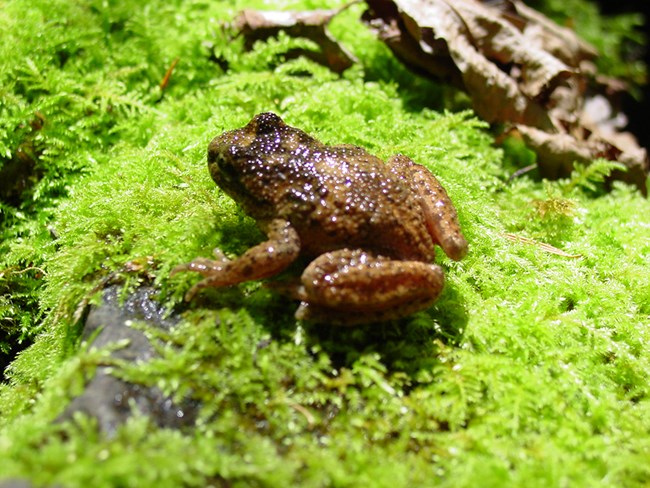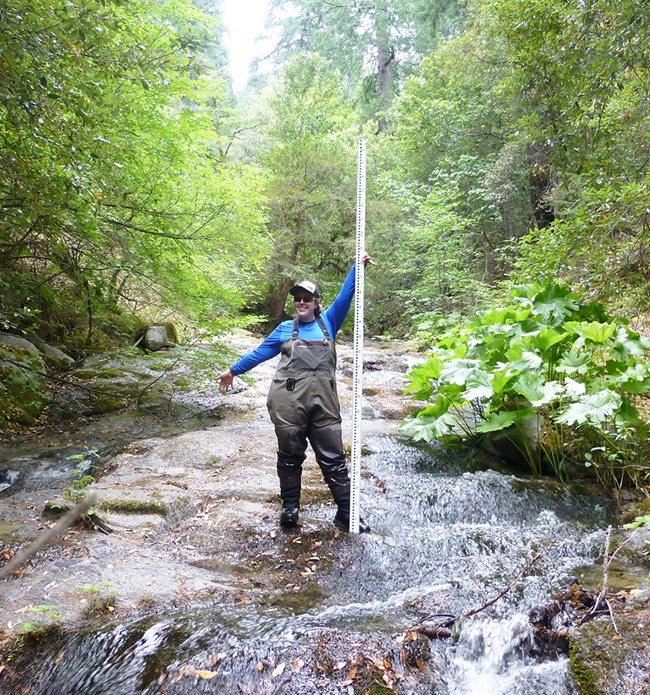Last updated: January 22, 2025
Article
Checking Whiskeytown's Vital Signs

NPS
Klamath Network Science
National parks are the guardians of our unique American natural and cultural history. But perhaps more than ever before, parks exist in a rapidly changing landscape. Urban growth, replacement of native species by exotics, air and water pollution, increasing visitor use, frequent wildfires, and climate change all impact the natural web of life. This leads us to ask:
How healthy are our parks?
How are they changing?
To answer these questions, the National Park Service created the Inventory and Monitoring Program, which is implemented at 32 networks of parks across the nation. In 2010 at Whiskeytown and nearby parks, the Klamath Network began monitoring selected natural resources, called “vital signs,” that serve as indicators of park condition. We make repeated visits to fixed sampling sites over time to track status and trends in these indicators and ultimately, to help park managers make science-based management decisions.
What Do We Monitor at Whiskeytown National Recreation Area?
Birds

NPS/Gary Lindquist
Birds delight us with song and beauty, but also with scientific data! Easily detected, they are good indicators of ecological health because they respond quickly to environmental change. Critical to park health, they spread seed and pollen across the land. With the Klamath Bird Observatory, we monitor landbird communities in the park. One of the most common birds we find is the spotted towhee. In foothill scrub and chaparral habitat, it’s hard to miss its loud chirp-chirp-tzeeee. Our bird monitoring tracks the distribution and health of park birds and adds to regional landbird projects, like the Avian Knowledge Network Northwest.
During the breeding season, we count birds along transects to determine
-
the variety of species present
- the relative abundance of each species in the park
Learn more and find recent publications:

NPS/Angie Lucas
Plants and Early Detection of Nonnative, Invasive Species
Plant communities from California’s Central Valley, North Coast Mountains, and the Klamath/Siskiyou Mountains converge here to create the park’s unique “Whiskeytown Mix.” Oak savannah, chaparral, and conifer forests offer food, shelter, and breeding habitat for insects and wildlife. One uncommon member of this diverse community is gray pine (Pinus sabiniana), with its spindly shape and heavy, sharply tipped cones. Though ragged in appearance, it is remarkable for its ability to grow in rocky, dry areas and for the highly nutritious seeds in its cones. But disturbances, like invasive species and climate change, can ripple through ecosystems. Climate change has altered fire regimes in the park, leading to larger, more frequent burns. Shorter fire return intervals can affect the ability of native species, like the gray pine, to recover between fires. To track vegetation community health, we monitor plant abundance and variety. We also track woody debris conditions because heavy debris buildup can fuel hotter, larger, and longer-burning fires.

© Christopher Earle, Gymnosperm Database, with permission

NPS
While native plants dominate most of our vegetation plots, nonnatives (plants that evolved in a different place), like tree of heaven (Ailanthus altissima) and blackberry (Rubus armeniacus), do occur in the park. Nonnative plants can outcompete native plants, monopolize water, and change the soil, so we survey park roads and trails, where nonnatives most commonly occur, to inform possible management action.
Some resources we measure:
-
cover and diversity of native plants
-
cover and diversity of nonnative plants
-
regeneration, by tree seedling counts
-
mortality, by counting recently dead trees
-
fuel availability, by measuring woody debris and litter and duff depths
- live tree characteristics, like volume (basal area), canopy health, and height
Learn more and find recent publications:
https://www.nps.gov/im/klmn/vegetation.htm
https://www.nps.gov/im/klmn/invasives.htm

NPS
Water Quality and Aquatic Life
Wet areas abound with life, from the tiny aquatic insects that feed salamanders and bluebirds, to the lush greenery that feeds and shelters other wildlife. Cold, clear streams on the south side of Whiskeytown Lake flow over bedrock and boulders, supporting tailed frogs, salamanders, aquatic insects, and trout for fishing. Smaller, more sediment laden streams on the north side of the lake drain multiple use watersheds (timber and mining). In fast-flowing streams, the tailed frog has adapted to rushing water with a flattened profile, suction cup mouthparts as a tadpole, and a very unusual frog ability: internal fertilization. Unfortunately, these frogs and the park’s waters are vulnerable to climate change and other stressors, such as the devastating 2018 Carr Fire, potential marijuana grows, and the residue of historical acid mining in the northern watersheds. We sample fish, aquatic organisms, streamside plants, and water chemistry to track changes in the health of park streams over time.

NPS
Some resources we measure:
-
water quality, like oxygen, pH, and turbidity
-
water chemistry, like nutrients (nitrogen, phosphorous) and salts
-
water quantity
-
habitat features, like streamside vegetation, in-stream woody debris, and stream slope
- biodiversity, including fish, amphibians, algae, and aquatic macroinvertebrates (stream bugs)
Learn more and find recent publications:

More Information and Vital Sign Publications
Klamath Inventory and Monitoring Network
Download a printable pdf of this article.
Prepared by Sonya Daw and the Klamath Network staff.
